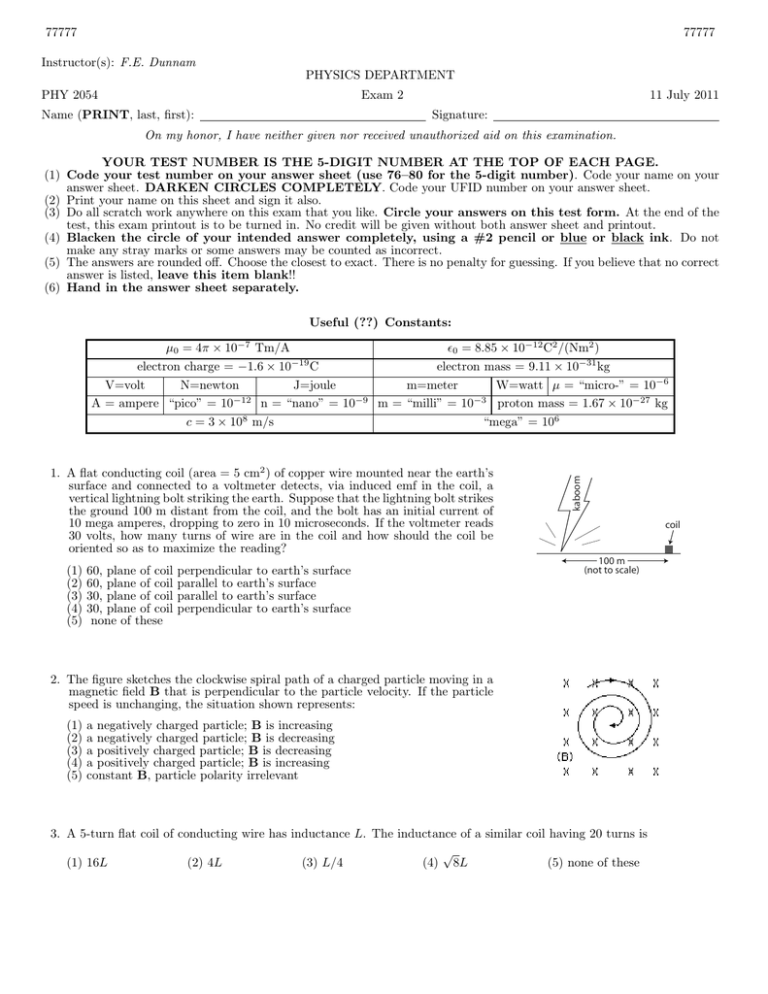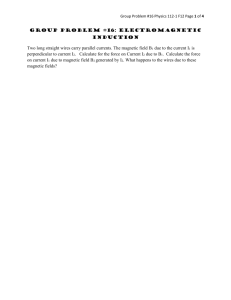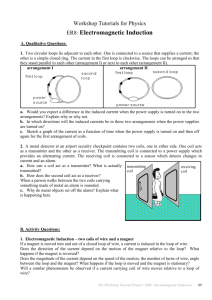77777 F.E. Dunnam PHYSICS DEPARTMENT PHY 2054
advertisement

77777 77777 Instructor(s): F.E. Dunnam PHYSICS DEPARTMENT PHY 2054 Exam 2 Name (PRINT, last, first): 11 July 2011 Signature: On my honor, I have neither given nor received unauthorized aid on this examination. YOUR TEST NUMBER IS THE 5-DIGIT NUMBER AT THE TOP OF EACH PAGE. (1) Code your test number on your answer sheet (use 76–80 for the 5-digit number). Code your name on your answer sheet. DARKEN CIRCLES COMPLETELY. Code your UFID number on your answer sheet. (2) Print your name on this sheet and sign it also. (3) Do all scratch work anywhere on this exam that you like. Circle your answers on this test form. At the end of the test, this exam printout is to be turned in. No credit will be given without both answer sheet and printout. (4) Blacken the circle of your intended answer completely, using a #2 pencil or blue or black ink. Do not make any stray marks or some answers may be counted as incorrect. (5) The answers are rounded off. Choose the closest to exact. There is no penalty for guessing. If you believe that no correct answer is listed, leave this item blank!! (6) Hand in the answer sheet separately. Useful (??) Constants: 1. A flat conducting coil (area = 5 cm2 ) of copper wire mounted near the earth’s surface and connected to a voltmeter detects, via induced emf in the coil, a vertical lightning bolt striking the earth. Suppose that the lightning bolt strikes the ground 100 m distant from the coil, and the bolt has an initial current of 10 mega amperes, dropping to zero in 10 microseconds. If the voltmeter reads 30 volts, how many turns of wire are in the coil and how should the coil be oriented so as to maximize the reading? (1) (2) (3) (4) (5) 60, plane of coil 60, plane of coil 30, plane of coil 30, plane of coil none of these perpendicular to earth’s surface parallel to earth’s surface parallel to earth’s surface perpendicular to earth’s surface kaboom µ0 = 4π × 10−7 Tm/A ²0 = 8.85 × 10−12 C2 /(Nm2 ) −19 electron charge = −1.6 × 10 C electron mass = 9.11 × 10−31 kg V=volt N=newton J=joule m=meter W=watt µ = “micro-” = 10−6 A = ampere “pico” = 10−12 n = “nano” = 10−9 m = “milli” = 10−3 proton mass = 1.67 × 10−27 kg c = 3 × 108 m/s “mega” = 106 coil 100 m (not to scale) 2. The figure sketches the clockwise spiral path of a charged particle moving in a magnetic field B that is perpendicular to the particle velocity. If the particle speed is unchanging, the situation shown represents: (1) (2) (3) (4) (5) a negatively charged particle; B is increasing a negatively charged particle; B is decreasing a positively charged particle; B is decreasing a positively charged particle; B is increasing constant B, particle polarity irrelevant 3. A 5-turn flat coil of conducting wire has inductance L. The inductance of a similar coil having 20 turns is √ (1) 16L (2) 4L (3) L/4 (4) 8L (5) none of these 77777 77777 4. An RLC series circuit, connected to a sinusoidal ac source E of frequency120 Hz, is at resonance. Under these conditions: (1) (2) (3) (4) (5) the the the the the voltage across R equals the applied voltage. voltage across R is zero. voltage across C is zero. voltage across L equals the applied voltage. applied voltage and currrent differ in phase by 90 degrees. 5. In the circuit shown, V0 = 45 volts, R1 = 10Ω, R2 = 5Ω, and L = 0.3H. Immediately after switch S is closed, the battery current is: (1) 3 A (2) 4.5 A (3) 9 A (4) 0 (zero) (5) insufficient data 6. A long time after the switch is closed in the above circuit, the current through the inductor will be approximately (1) 4.5 A (2) 3 A (3) 9 A (4) 0 (zero) (5) insufficient data 7. If the switch has remained closed for, say, 100 time constants, the energy stored in the inductor is (1) 3 J (2) 4.5 J (3) 1.35 J (4) 122 J 135 (5) √ J 2 8. An electron is moving southward in a region where the magnetic field is directed northward. The magnetic force exerted on the electron is: (1) zero (2) up (3) down (4) east (5) west 9. Two parallel long straight wires carry the same current and repel each other with a force F per unit length. If both currents are doubled and the wire separation tripled, the force per unit length becomes: (1) 4F/3 (2) 2F/9 (3) 2F/3 (4) 4F/9 (5) 6F 10. An 8.0-mH inductor and a 2.0-Ω resistor are wired in series to a 20-V ideal battery. A switch in the circuit is closed at time 0, at which time the current is 0. A long time after the switch is thrown the potential differences across the inductor and resistor are: (1) 0, 20 V (2) 20 V, 0 (3) 10 V, 10 V (4) 16 V, 4 V (5) unknown since the rate of change of the current is not given 11. In an ideal 8:1 step-down transformer the primary power is 10 kW and the secondary current is 25 A. The primary voltage must therefore be (1) 3200 (2) 25,600 (3) 400 (4) 50 (5) 6.25 77777 77777 12. The direction of travel of an electromagnetic wave such as that produced by an antenna is oriented in what direction with respect to the associated electric (E) and magnetic (B) fields? (1) (2) (3) (4) (5) perpendicular to both E and B parallel to both E and B parallel to E, perpendicular to B parallel to B, perpendicular to E none of these 13. In the circuit shown at right, R = R = 10kΩ, C = 200µF, and E = 40 V. When S is closed, the time constant for charging C is (in seconds): S R C E R (1) 2 (2) 4 (3) 0.5 (4) 1 (5) none of these 14. For the above circuit, when S is open, the time constant for discharge of capacitor C (in seconds) is (1) 4 (2) 2 (3) 0.5 (4) 1 (5) none of these 15. Many do-it-yourself outdoor home lighting kits are ‘low-voltage’ systems, using a transformer that steps-down the 120V household voltage to 24V in the interest of safety. Suppose that in such a system the combined resistance of the outdoor lights is 2 ohms. What will be the current in the secondary and primary coils of the transformer, respectively? (1) 12, 2.4 (2) 2.4, 12 (3) 6, 12 (4) 12, 6 (5) 48, 10 16. Two identical electric lamps A and B are hooked together as shown in the diagram. When the switch at the center is closed, what now happens to the intensity (brightness) of each lamp compared to its initial intensity? [Hint: lamp intensity is proportional to energy dissipated.] (1) (2) (3) (4) (5) A A A A A brighter ; B dimmer brighter ; B brighter dimmer ; B dimmer dimmer ; B brighter stays the same ; B stays the same 17. The current-carrying loop in the diagram is released from rest in the uniform magnetic field shown. About which axis does it rotate? (1) (2) (3) (4) (5) x-axis y-axis z-axis There is no torque on the loop so it does not rotate. Depends on whether the charge carriers are positive or negative. 18. Identical currents I flow in the long straight conductor and the circular loop shown in the diagram. If r = 2cm and I = 3A, find the magnetic field strength in T at the center of the circular loop. (1) 7.9 × 10−5 (2) 1.1 × 10−4 (3) 9.4 × 10−5 (4) 1.5 × 10−5 (5) zero 77777 77777 19. The figure shows a uniform magnetic field which is normal to the plane of a conducting circular loop of resistance 1.5Ω and radius 0.024 m. The magnetic field has a magnitude of 3.0 T and is directed up out of the paper. The area of the rectangular portion of the loop is negligible compared to that of the circular loop. What is the average current in the loop if the magnitude of the magnetic field is doubled in 0.4 s? (1) (2) (3) (4) (5) 9.0 × 10−3 2.8 × 10−3 4.5 × 10−3 4.5 × 10−3 9.0 × 10−3 A, A, A, A, A, clockwise clockwise clockwise counter-clockwise counter-clockwise 20. A single circular loop of 1.0 m radius carries a current of 10.0 mA. It is placed in a uniform magnetic field of magnitude 0.50 T that is directed parallel to the plane of the loop as suggested in the figure. What is the magnitude of the torque exerted on the loop by the magnetic field? (1) 1.57 × 10−2 N·m (2) 3.14 × 10−2 N·m (3) 6.28 × 10−2 N·m (4) 9.28 × 10−2 N·m (5) 10 N·m THE FOLLOWING QUESTIONS, NUMBERED IN THE ORDER OF THEIR APPEARANCE ON THE ABOVE LIST, HAVE BEEN FLAGGED AS CONTINUATION QUESTIONS: 6 7 14





